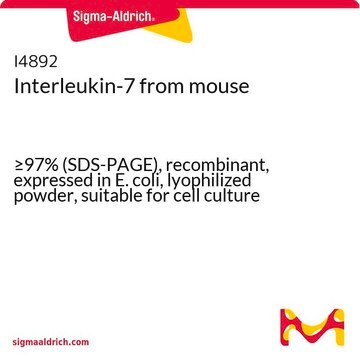Kluczowe dokumenty
K0254
Kanamycin solution from Streptomyces kanamyceticus
liquid, suitable for cell culture and plant cell culture, BioReagent
Synonim(y):
Kanamycyna A
About This Item
Polecane produkty
Nazwa produktu
Kanamycin solution from Streptomyces kanamyceticus, 50 - 60 mg/mL in 0.9% NaCl, BioReagent, liquid, 0.1 μm filtered, suitable for cell culture
pochodzenie biologiczne
Streptomyces kanamyceticus
sterylność
0.1 μm filtered
linia produktu
BioReagent
Formularz
liquid
stężenie
50 - 60 mg/mL in 0.9% NaCl
metody
cell culture | mammalian: suitable
cell culture | plant: suitable
zanieczyszczenia
endotoxin, tested
spektrum działania antybiotyku
Gram-negative bacteria
Gram-positive bacteria
mycobacteria
mycoplasma
Tryb działania
protein synthesis | interferes
temp. przechowywania
2-8°C
ciąg SMILES
NC[C@H]1O[C@H](O[C@@H]2[C@@H](N)C[C@@H](N)[C@H](O[C@H]3O[C@H](CO)[C@@H](O)[C@H](N)[C@H]3O)[C@H]2O)[C@H](O)[C@@H](O)[C@@H]1O
InChI
1S/C18H36N4O11/c19-2-6-10(25)12(27)13(28)18(30-6)33-16-5(21)1-4(20)15(14(16)29)32-17-11(26)8(22)9(24)7(3-23)31-17/h4-18,23-29H,1-3,19-22H2/t4-,5+,6-,7-,8+,9-,10-,11-,12+,13-,14-,15+,16-,17-,18-/m1/s1
Klucz InChI
SBUJHOSQTJFQJX-NOAMYHISSA-N
Szukasz podobnych produktów? Odwiedź Przewodnik dotyczący porównywania produktów
Opis ogólny
Zastosowanie
- to induce deafness in neonatal rats
- as an endothelial growth medium component for culturing human umbilical vein endothelial cells (HUVECs)
- as medium component for Mycobacteria Cultures and Top10 E coli cells
Działania biochem./fizjol.
Mode of Resistance: Aminoglycoside-modifying enzymes (including acetyltransferase, phosphotransferase, nucleotidyltransferase) can alter this antibiotic, preventing its interaction with ribosomes.
Antimicrobial spectrum: Kanamycin sulfate is effective against gram-negative and gram-postiive bacteria, and mycoplasma.
Przestroga
Hasło ostrzegawcze
Danger
Zwroty wskazujące rodzaj zagrożenia
Zwroty wskazujące środki ostrożności
Klasyfikacja zagrożeń
Repr. 1B
Kod klasy składowania
6.1C - Combustible acute toxic Cat.3 / toxic compounds or compounds which causing chronic effects
Klasa zagrożenia wodnego (WGK)
WGK 2
Temperatura zapłonu (°F)
Not applicable
Temperatura zapłonu (°C)
Not applicable
Wybierz jedną z najnowszych wersji:
Masz już ten produkt?
Dokumenty związane z niedawno zakupionymi produktami zostały zamieszczone w Bibliotece dokumentów.
Klienci oglądali również te produkty
Produkty
Antibiotic kill curve is a dose response experiment in which mammalian cells are subjected to increasing amounts of selection antibiotic
Krzywa zabijania antybiotyków to eksperyment dawka-odpowiedź, w którym komórki ssaków są poddawane rosnącej ilości antybiotyku selekcyjnego.
Nasz zespół naukowców ma doświadczenie we wszystkich obszarach badań, w tym w naukach przyrodniczych, materiałoznawstwie, syntezie chemicznej, chromatografii, analityce i wielu innych dziedzinach.
Skontaktuj się z zespołem ds. pomocy technicznej





